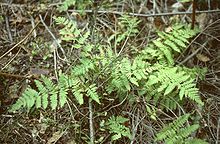Dryopteridaceae
| Dryopteridaceae | |
|---|---|

| |
| Dryopteris carthusiana | |
| Scientific classification | |
| Kingdom: | Plantae |
| Clade: | Tracheophytes |
| Division: | Polypodiophyta |
| Class: | Polypodiopsida |
| Order: | Polypodiales |
| Suborder: | Polypodiineae |
| Family: | Dryopteridaceae Herter (nom. cons.) |
| Subfamilies | |
| |
| Synonyms | |
| |
The Dryopteridaceae are a family of leptosporangiate ferns in the order Polypodiales. They are known colloquially as the wood ferns. In the Pteridophyte Phylogeny Group classification of 2016 (PPG I), the family is placed in the suborder Polypodiineae.[1] Alternatively, it may be treated as the subfamily Dryopteridoideae of a very broadly defined family Polypodiaceae sensu lato.[2]
The family contains about 1700
Description
The
Taxonomy
History
In 1990, Karl U. Kramer and coauthors defined the Dryopteridaceae broadly to include the present family, as well as the
In 2007, a
Some species have been removed from the genus
In 2012, a phylogenetic study of Dryopteris and its relatives included Acrophorus, Acrorumohra, Diacalpe, Dryopsis, Nothoperanema, and Peranema within that genus.[12] The Flora of China treatment of the family, published in 2013, used phylogenetic results to sink Lithostegia and Phanerophlebiopsis into Arachniodes.[13]
The Dryopteridaceae
Phylogeny
The following cladogram for the suborder Polypodiineae (eupolypods I), based on the consensus cladogram in the Pteridophyte Phylogeny Group classification of 2016 (PPG I),[1] shows a likely phylogenetic relationship between Dryopteridaceae and the other families of the clade.
| Polypodiineae (eupolypods I) |
| ||||||||||||||||||||||||||||||||||||||||||||||||
Subdivision
| Phylogeny of Dryopteridaceae[15][16] | |||||||||||||||
|
The PPG I classification divides the family into three subfamilies, listed below.[1]
- Subfamily Polybotryoideae H.M.Liu & X.C.Zhang
- Cyclodium C.Presl
- Maxonia C.Chr.
- Olfersia Raddi
- Polybotrya Humb. & Bonpl. ex Willd.
- Polystichopsis (J.Sm.) Holttum
- Stigmatopteris C.Chr.
- Trichoneuron Ching
- Subfamily Elaphoglossoideae (Pic.Serm.) Crabbe, Jermy & Mickel
- Arthrobotrya J.Sm.
- Bolbitis Schott
- Elaphoglossum Schott ex J.Sm.
- Lastreopsis Ching
- Lomagramma J.Sm.
- Megalastrum Holttum
- Mickelia R.C.Moran, Labiak & Sundue
- Parapolystichum (Keyserl.) Ching
- Pleocnemia C.Presl
- Rumohra Raddi
- Teratophyllum Mett. ex Kuhn
- Subfamily Dryopteridoideae Link
- Arachniodes Blume
- Ctenitis (C.Chr.) C.Chr.
- Cyrtomium C.Presl
- Dryopteris Adans.
- Phanerophlebia C.Presl
- Polystichum Roth
References
- ^ S2CID 39980610.
- PMID 24532607.
- ISBN 978-0-88192-819-8
- ^ a b c Smith et al., 2006 Archived February 26, 2008, at the Wayback Machine Alan R. Smith, Kathleen M. Pryer, Eric Schuettpelz, Petra Korall, Harald Schneider & Paul G. Wolf: "A classification for extant ferns," Taxon, 55(3): 705–731 (Aug 2006)
- ISBN 978-0-387-51794-0
- ^ ISBN 978-0-521-87411-3
- ISSN 1179-3163.
- doi:10.1086/521710
- doi:10.1086/652191
- ^ Robbin C. Moran, Paulo H. Labiak, and Michael Sundue. 2010. "Synopsis of Mickelia, a newly recognized genus of bolbitidoid ferns (Dryopteridaceae)". Brittonia 62(4):337-356.
- ^ Li-Bing Zhang, Liang Zhang, Shi-Yong Dong, and Atsushi Ebihara. 2012. "Molecular circumscription and major evolutionary lineages of the fern genus Dryopteris (Dryopteridaceae)". BMC Evolutionary Biology 12(1):180
- ^ He H, Wu SG, Xiang JY, Barrington DS (2013) "Arachniodes". In: Wu ZY, Raven PH, Hong DY (eds) Flora of China, vol 2–3.
- ^ Christenhusz & Chase 2014.
- PMID 36092417.
- ^ "Tree viewer: interactive visualization of FTOL". FTOL v1.3.0. 2022. Retrieved 12 December 2022.
- S2CID 4573970.
- PMID 28781553.
Bibliography
- Smith, Alan R.; Pryer, Kathleen M.; Schuettpelz, Eric; Korall, Petra; Schneider, Harald; Wolf, Paul G. (1 January 2006). "A Classification for Extant Ferns" (PDF). JSTOR 25065646.
